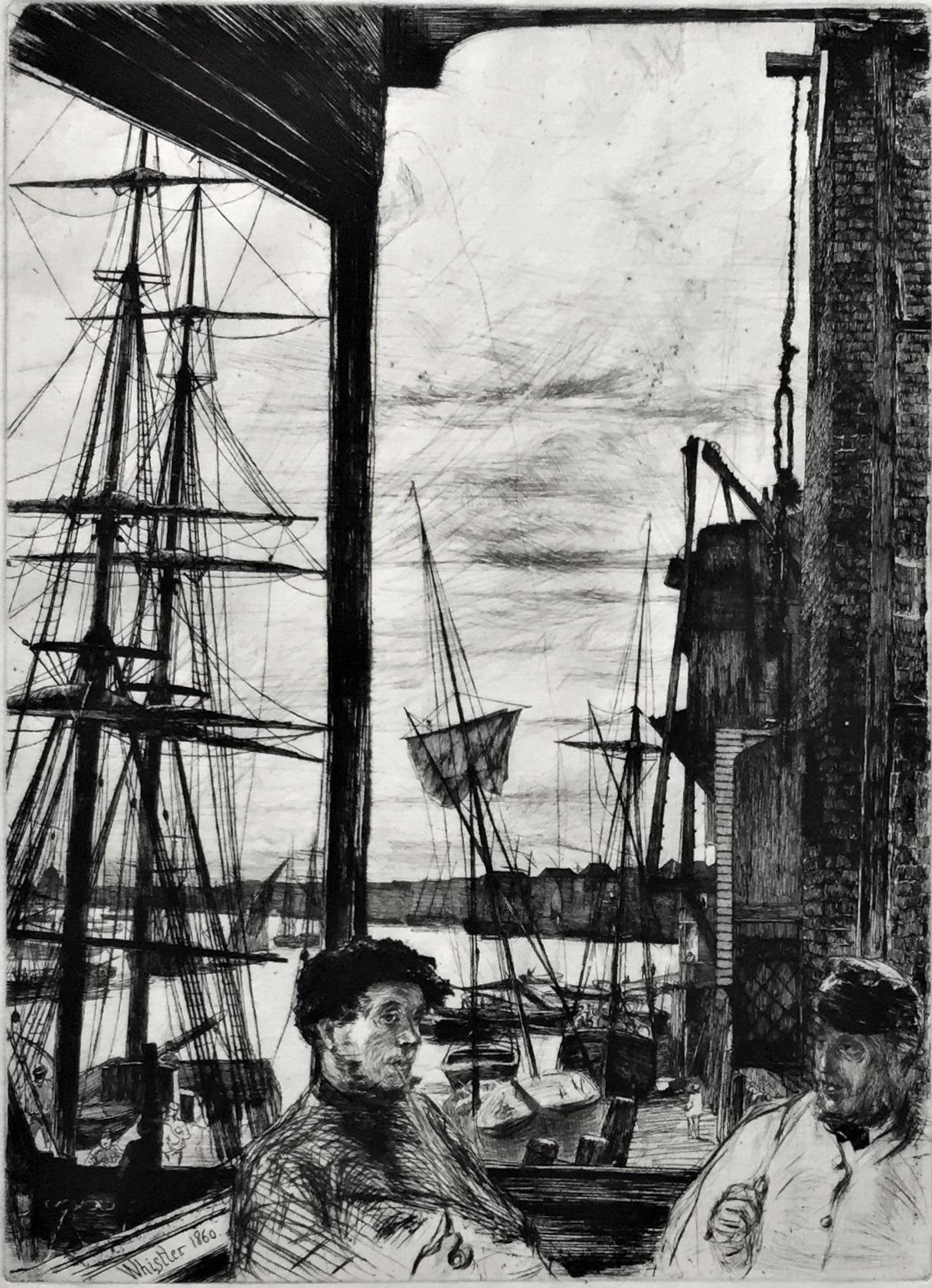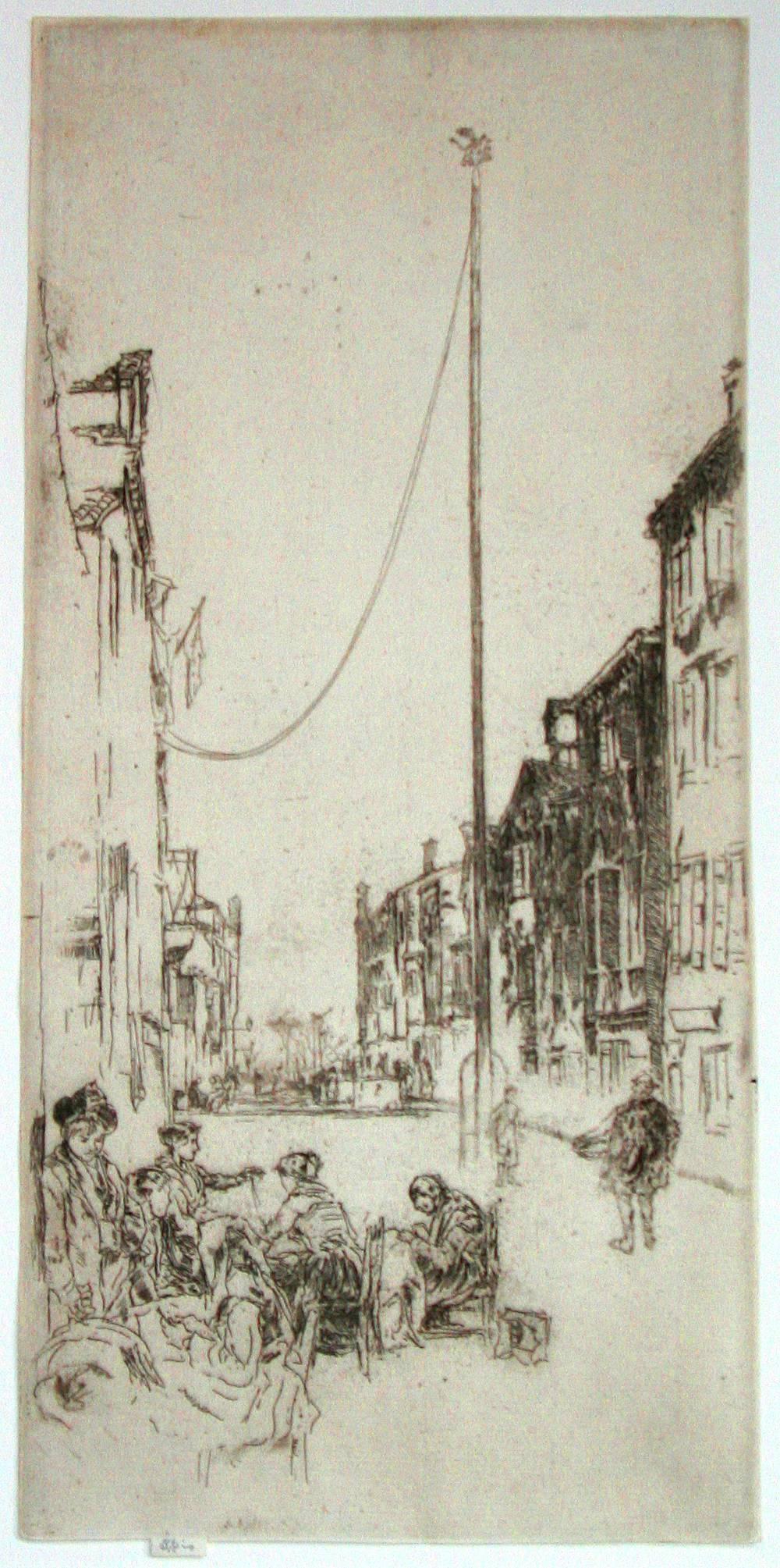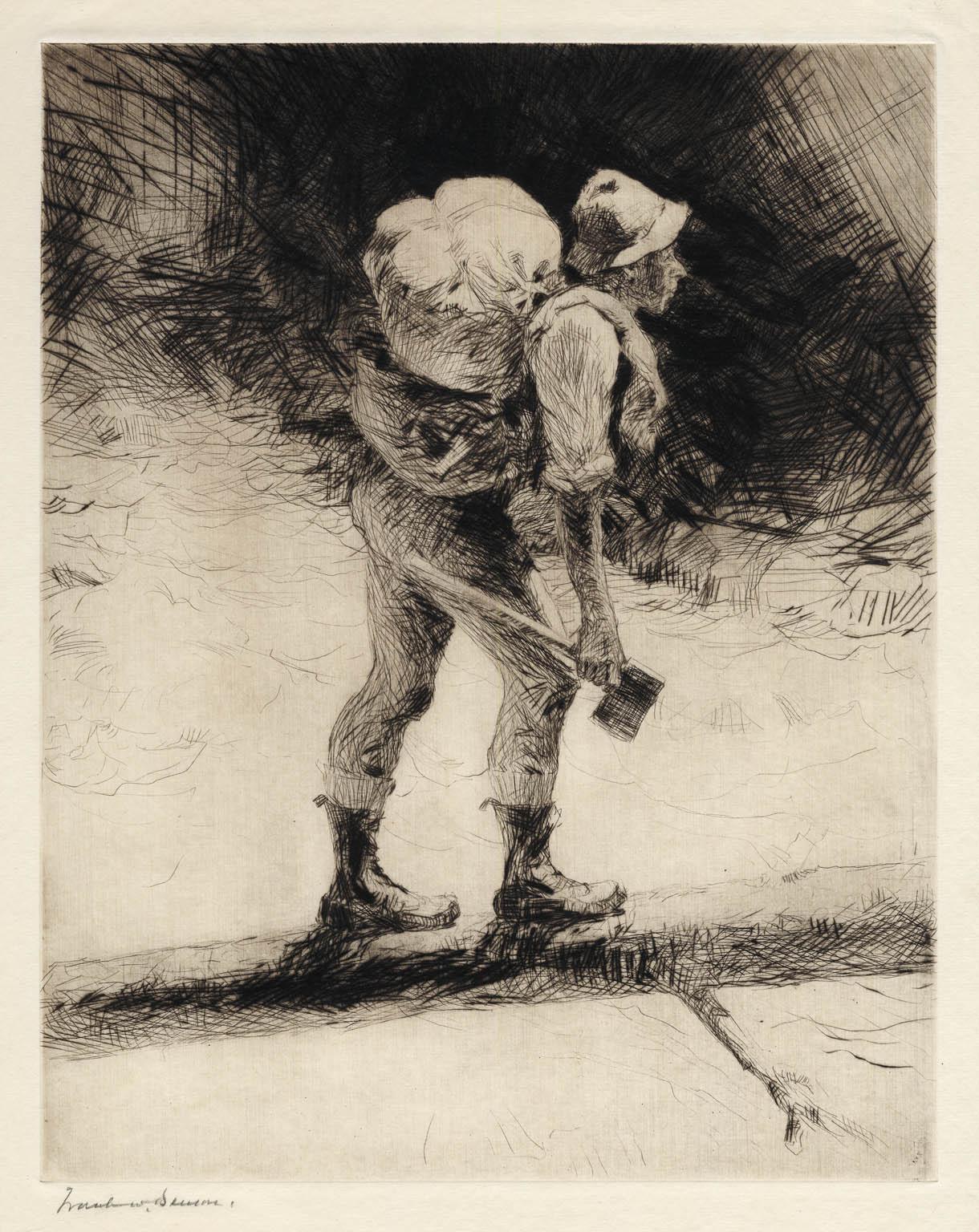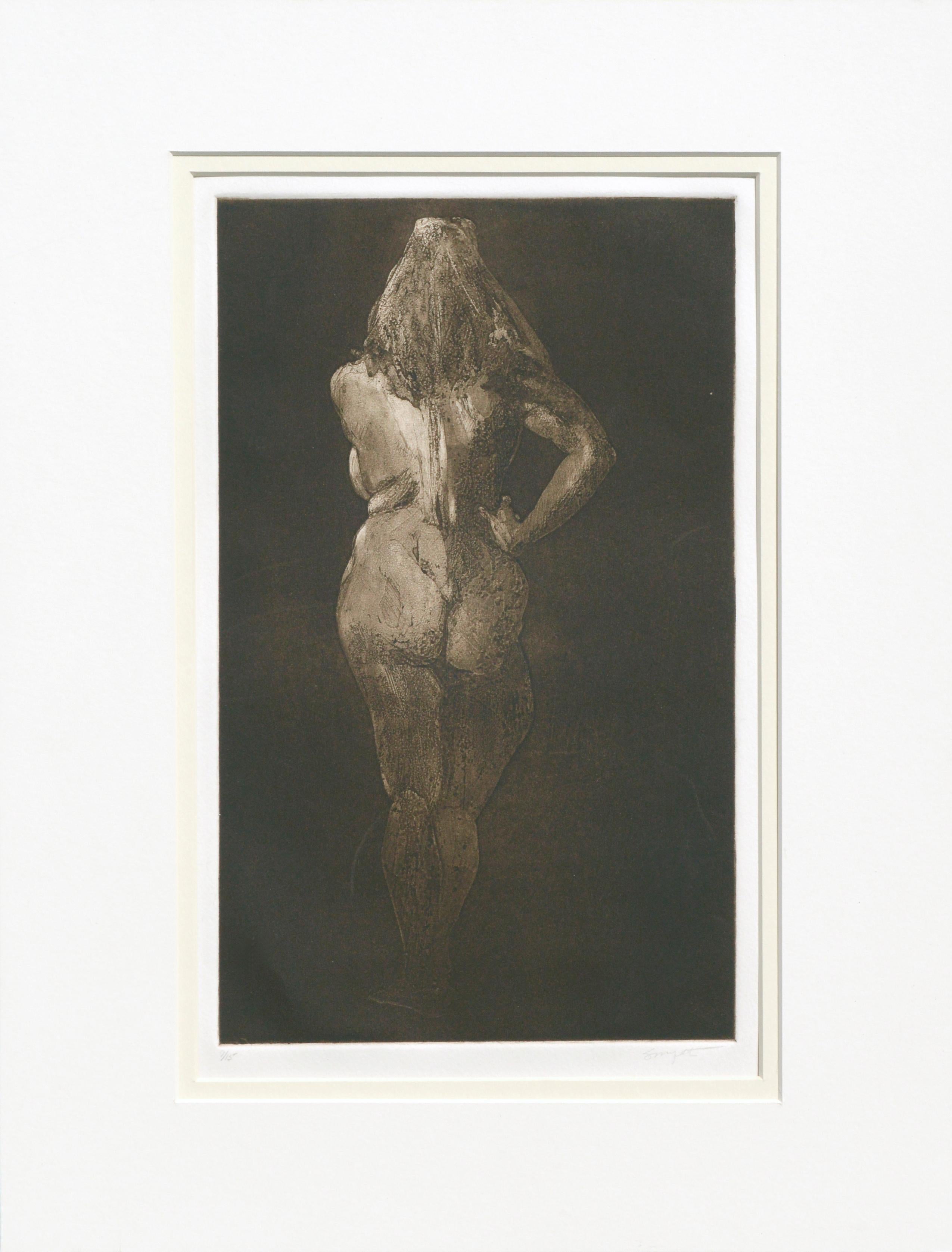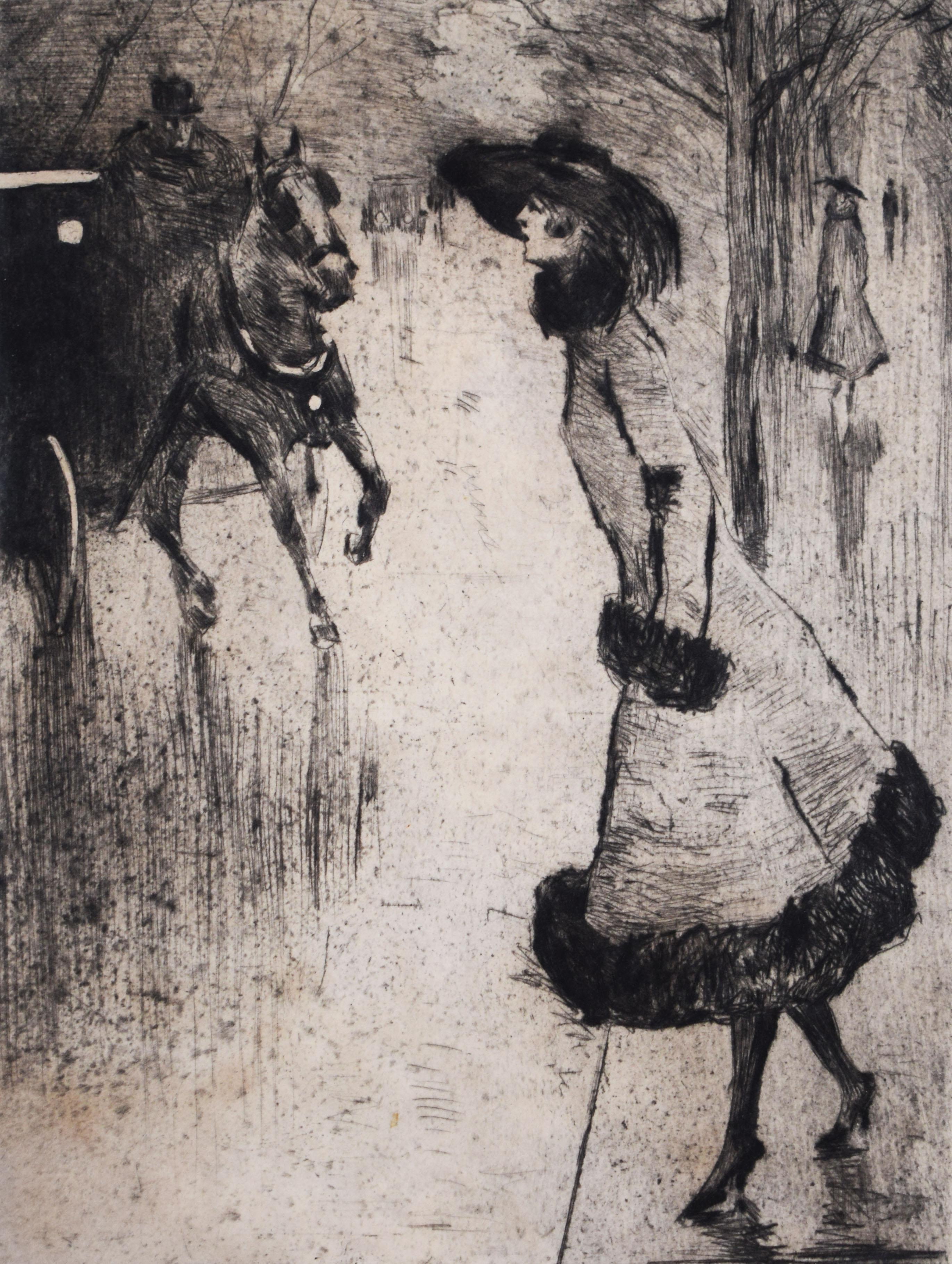Items Similar to 'Grand Central Station' — 1920s New York City
Want more images or videos?
Request additional images or videos from the seller
1 of 3
Otto Kuhler'Grand Central Station' — 1920s New York City1927
1927
About the Item
Otto Kuhler, 'Grand Central Station', etching and drypoint, 1927, edition c. 50, Kennedy 27. Signed and titled in pencil. A superb, richly-inked impression, in brown/black ink, with selectively wiped plate tone, on cream wove paper; the full sheet with wide margins (2 to 2 3/4 inches) in excellent condition. Printed by the artist. Matted to museum standards, unframed.
Image size 14 3/8 x 8 15/16 (363 x 227 mm); sheet size 19 1/8 x 13 3/8 (486 x 338 mm).
New York City's Grand Central Station viewed from the south, with the elevated section of Park Avenue in the lower right.
ABOUT THE ARTIST
Otto Kuhler (1894, Remscheid, Germany -1977, New York City) was a prolific artist and visionary industrial designer whose creative vision left enduring contributions to the worlds of art and transportation.
Kuhler's early years were marked by a deep fascination with machines and technology, a passion that would later shape his artistic career. After studying engineering in Germany, he immigrated to the United States in 1923, where he began to pursue his artistic ambitions in earnest.
Throughout the 1920s and 1930s, Kuhler's distinctive artistic style began to emerge, characterized by bold colors, geometric forms, and dynamic compositions. His modernist aesthetic caught the attention of the burgeoning industrial design community, leading to collaborations with prominent companies such as the American Locomotive Company (ALCO) and the Electro-Motive Corporation (EMC).
Kuhler's most enduring contributions came in the realm of locomotive design, where his innovative concepts revolutionized the aesthetics and functionality of trains. His streamlined locomotives, with their sleek, futuristic designs, captured the spirit of the modern age and helped define the visual identity of rail travel in the mid-20th century. His innovative influence on industrial design and transportation aesthetics is still felt today.
In addition to his work in industrial design, Kuhler was also a prolific painter, illustrator, and printmaker known for his detailed landscapes and dynamic cityscapes. His work often reflected his fascination with technology and machinery, juxtaposing natural and industrial elements to create compelling visual narratives. Kuhler’s printmaking oeuvre was represented by the renowned Kennedy Galleries in New York City.
Kuhler's legacy endures through his extensive body of work, which is represented in galleries, private collections and museums around the world including the Brooklyn Museum, Cleveland Museum of Art, Denver Public Library, Fine Arts Museums of San Francisco, Henry Ford Museum, National Gallery of Art, National Museum of American History, New Mexico Museum of Art, New York Transit Museum, Railroad Museum of Pennsylvania, Roentgen Museum (Remscheid, Germany), University of Missouri at St. Louis, and the Westmoreland Museum of American Art.
- Creator:Otto Kuhler (1894 - 1977, German)
- Creation Year:1927
- Dimensions:Height: 14.38 in (36.53 cm)Width: 8.94 in (22.71 cm)
- Medium:
- Movement & Style:
- Period:
- Condition:
- Gallery Location:Myrtle Beach, SC
- Reference Number:
About the Seller
5.0
Recognized Seller
These prestigious sellers are industry leaders and represent the highest echelon for item quality and design.
Platinum Seller
These expertly vetted sellers are 1stDibs' most experienced sellers and are rated highest by our customers.
Established in 1995
1stDibs seller since 2016
254 sales on 1stDibs
Typical response time: 2 hours
Associations
International Fine Print Dealers Association
- ShippingRetrieving quote...Ships From: Myrtle Beach, SC
- Return PolicyA return for this item may be initiated within 7 days of delivery.
More From This SellerView All
- 'Fantasia Americana - 1880' — Mid-Century American SurrealismBy Lawrence KupfermanLocated in Myrtle Beach, SCLawrence Kupferman, 'Fantasia Americana – 1880', drypoint etching with sandground, 1943. Signed, titled, and annotated 'Series A, 1971 2/6' in pencil. A superb, richly-inked impression, on heavy, cream wove paper, with full margins (2 1/2 to 3 1/2 inches); the paper slightly lightened within the original mat opening, otherwise in excellent condition. One of only 6 impressions printed in 1971, with the added sandground grey background tint. Image size 11 13/16 x 14 3/4 inches; sheet size 18 x 20 1/4 inches. Archivally matted to museum standards, unframed. Collections: National Gallery of Art, Zimmerli Art Museum (Rutgers University). ABOUT THE ARTIST Lawrence Kupferman (1909 - 1982) was born in the Dorchester neighborhood of Boston and grew up in a working-class family. He attended the Boston Latin School and participated in the high school art program at the Museum of Fine Arts, Boston. In the late 1920s, he studied drawing under Philip Leslie Hale at the Museum School—an experience he called 'stultifying and repressive'. In 1932 he transferred to the Massachusetts College of Art, where he first met his wife, the artist Ruth Cobb. He returned briefly to the Museum School in 1946 to study with the influential expressionist German-American painter Karl Zerbe. Kupferman held various jobs while pursuing his artistic career, including two years as a security guard at the Museum of Fine Arts, Boston. During the 1930s he worked as a drypoint etcher for the Federal Art Project, creating architectural drawings in a formally realistic style—these works are held in the collections of the Fogg Museum and the Smithsonian American Art Museum. In the 1940s he began incorporating more expressionistic forms into his paintings as he became progressively more concerned with abstraction. In 1946 he began spending summers in Provincetown, Massachusetts, where he met and was influenced by Mark Rothko, Hans Hofmann, Jackson Pollock, and other abstract painters. At about the same time he began exhibiting his work at the Boris Mirski Gallery in Boston. In 1948, Kupferman was at the center of a controversy involving hundreds of Boston-area artists. In February of that year, the Boston Institute of Modern Art issued a manifesto titled 'Modern Art and the American Public' decrying 'the excesses of modern art,' and announced that it was changing its name to the Institute of Contemporary Art (ICA). The poorly conceived statement, intended to distinguish Boston's art scene from that of New York, was widely perceived as an attack on modernism. In protest, Boston artists such as Karl Zerbe, Jack Levine, and David Aronson formed the 'Modern Artists Group' and organized a mass meeting. On March 21, 300 artists, students, and other supporters met at the Old South Meeting House and demanded that the ICA retract its statement. Kupferman chaired the meeting and read this statement to the press: “The recent manifesto of the Institute is a fatuous declaration which misinforms and misleads the public concerning the integrity and intention of the modern artist. By arrogating to itself the privilege of telling the artists what art should be, the Institute runs counter to the original purposes of this organization whose function was to encourage and to assimilate contemporary innovation.” The other speakers were Karl Knaths...Category
1940s Surrealist Figurative Prints
MaterialsDrypoint, Etching
- Of Youth —after Gustav Mahler's 'The Song of the Earth'Located in Myrtle Beach, SCArthur Paunzen, 'Von der Jugend' (Of Youth) from the suite 'Song of the Earth', etching, aquatint, and drypoint, 1920. Signed and titled in pencil. Signed in the plate, lower left. A fine, richly-inked impression, on cream, wove Japan paper; the full sheet with margins (2 1/4 to 4 1/4 inches), in good condition. Image size 12 1/4 x 9 1/16 inches; sheet size 19 3/4 x 13 5/8 inches. Matted to museum standards, unframed. ABOUT THIS WORK Pauzen’s suite of six etchings 'Das Lied von der Erde' (The Song of the Earth), published in 1920, was inspired by Gustav Mahler...Category
1920s Vienna Secession Figurative Prints
MaterialsEtching, Drypoint, Aquatint
- Of Beauty —after Gustav Mahler's 'The Song of the Earth'Located in Myrtle Beach, SCArthur Paunzen, 'Von der Schönheit' (Of Beauty) from the suite 'Song of the Earth', etching, aquatint, and drypoint, 1920. Signed and titled in pencil. Signed in the plate, lower left. A fine, richly-inked impression, on cream, wove Japan paper; the full sheet with margins (2 1/4 to 4 1/4 inches), in good condition. Image size 12 3/8 x 9 inches; sheet size 19 5/8 x 13 5/8 inches. Matted to museum standards, unframed. ABOUT THIS WORK Pauzen’s suite of six etchings 'Das Lied von der Erde' (The Song of the Earth), published in 1920, was inspired by Gustav Mahler...Category
1920s Vienna Secession Figurative Prints
MaterialsEtching, Drypoint, Aquatint
- The Solitary One in Autumn—after Gustav Mahler's 'The Song of the Earth'Located in Myrtle Beach, SCArthur Paunzen, 'Der Einsame im Herbst' (The Solitary One in Autumn) from the suite 'Song of the Earth', etching, aquatint, and drypoint, 1920. Signed and titled in pencil. Signed in the plate, lower left. A fine, richly-inked impression, on cream, wove Japan paper; the full sheet with margins (2 3/8 to 4 1/8 inches), in good condition. Image size 12 3/8 x 8 7/8 inches; sheet size 19 5/8 x 13 3/4 inches. Matted to museum standards, unframed. ABOUT THIS WORK Pauzen’s suite of six etchings 'Das Lied von der Erde' (The Song of the Earth), published in 1920, was inspired by Gustav Mahler...Category
1920s Vienna Secession Figurative Prints
MaterialsEtching, Drypoint, Aquatint
- 'Cargo Carriers' — 1930s New York HarborBy Otto KuhlerLocated in Myrtle Beach, SCOtto Kuhler, 'Cargo Carriers', etching and drypoint, c. 1932, edition 10, Kennedy 44. Signed in pencil. A superb, atmospheric impression with rich burr and selectively wiped overall plate tone, in dark brown ink, on Arches cream laid paper; wide margins (2 to 2 3/4 inches), in very good condition. Printed by the artist. Original Kennedy Galleries mat and label. Scarce. "On my trips up and down N.Y. harbor on the Weehawken Ferry, the late evening sun playing on the side of the big liners has always intrigued me... The liner shown I believe to be the Vaterland of the North German Lloyd...Category
1930s American Modern Figurative Prints
MaterialsEtching, Drypoint
- The Drunkard in Spring —after Gustav Mahler's 'The Song of the Earth'Located in Myrtle Beach, SCArthur Paunzen, 'Der Trunkene im Frühling' (The Drunkard in Spring) from the suite 'Song of the Earth', etching, aquatint, and drypoint, 1920. Signed and titled in pencil. Signed in the plate, lower right. A fine, richly-inked impression, on cream, wove Japan paper; the full sheet with margins (2 1/4 to 4 1/4 inches), in good condition. Image size 12 3/8 x 9 1/8 inches; sheet size 19 5/8 x 13 5/8 inches. Matted to museum standards, unframed. ABOUT THIS WORK Pauzen’s suite of six etchings 'Das Lied von der Erde' (The Song of the Earth), published in 1920, was inspired by Gustav Mahler...Category
1920s Vienna Secession Figurative Prints
MaterialsEtching, Drypoint, Aquatint
You May Also Like
- RotherhitheBy James Abbott McNeill WhistlerLocated in Storrs, CTRotherhithe (Originally published as Wapping). 1860. Etching. Kennedy catalog 66 state iii; Glasgow catalog 70. state vi. 10 3/4 x 7 3/4 (sheet 12 7/8 x 9 1/2). Series: "Sixteen Etc...Category
Mid-19th Century American Impressionist Figurative Prints
MaterialsDrypoint, Etching
- The Venetian MastBy James Abbott McNeill WhistlerLocated in Storrs, CTThe Venetian Mast. 1879-80. Etching and drypoint. Kennedy catalog 195 state .vi; Glasgow catalog 219 state x/xii. 13 3/8 x 6 3/8. Glasgow records 53 impressions. A fine, atmospheric...Category
1870s American Impressionist Landscape Prints
MaterialsDrypoint, Etching
- Resurrection (aka Flying Figures; Border of the Lake)By Arthur B. DaviesLocated in New York, NYArthur B. Davies (1862-1928), Resurrection (aka Flying Figures; Border of the Lake), drypoint and aquatint on zinc, 1916, signed with the estate stamp lower right. Reference: Price 2...Category
1910s American Impressionist Figurative Prints
MaterialsDrypoint, Aquatint
- The BridgeBy Frank BensonLocated in New York, NY"The Bridge" is a drypoint by Frank Benson created in 1923. Printed in an edition of 150 this impression is signed in pencil, lower left. The image size is 13 1/2 x 10 5/8" (34.2 x 26.8 cm) and sheet size 16 1/2 x 13 1/16" (41.8 x 33.3 cm). FRANK W. BENSON (1862-1951) Frank Weston Benson, well known for his American impressionist paintings, also produced an incredible body of prints - etchings, drypoints, and a few lithographs. Born and raised on the North Shore of Massachusetts, Benson, a natural outdoorsman, grew up sailing, fishing, and hunting. From a young age, he was fascinated with drawing and birding – this keen interest continued throughout his life. His first art instruction was with Otto Grundman at the Museum of Fine Arts in Boston, and then in 1883 in Paris at the Academie Julian where he studied the rigorous ‘ecole des beaux arts’ approach to drawing and painting for two years. During the early 1880’s Seymour Haden visited Boston giving a series of lectures on etching. This introduction to the European etching...Category
1920s American Impressionist Figurative Prints
MaterialsDrypoint
- Nude Figure Posterior View, Figurative Drypoint EtchingBy Jim SmythLocated in Soquel, CALimited edition drypoint etching of a nude figure from a posterior view by Jim Smyth (American, b. 1938). Numbered and signed by hand "7/15 Jim Smyth" along the bottom edge. Presented in a new cream and off-white double mat. No frame. Image size: 14.75"H x 10.75"W Jim Smyth (American, b. 1938) has studied at the Academia de Belle Arti in Fiorenza, Italy, Ecole des BeauxArts in Geneva, New York Academy and the Art Students league. He is also a graduate from UC Berkeley with a degree in Fine Art. Although academically trained, Smyth practices and teaches a more impressionistic style of painting, focusing on Alla Prima technique. He is particularly knowledgeable about drawing, perspective, color theory and the human figure, his passion. Smyth, with an extensive academic knowledge, has a profound love of all human representations as illustrated by his humorous quick sketches from life. He also practices and teaches oil painting and pastels. When not in Provence, or Southeastern France, Smyth teaches intensely in art schools, art centers and several colleges in the Bay Area. He is a beloved instructor and his classes fill in quickly as he is very knowledgeable. On his return to the United States, he began studying with Mr. Alanson Appleton at the College of San Mateo, San Mateo, California. Smyth was a founding member of the Appletree Etchers, Inc., an etching print shop organized by Mr. Appleton and his students to develop and promote color intaglio. Smyth served as Master Printer at the studio for many years perfecting the techniques of intaglio and developing the color theories of Mr. Appleton as applied to the deep etched plate. Smyth received his degree from the University of California, Berkeley, in 1972 and holds the California Community College Certificate and an Adult Education Certificate. Smyth was invited to teach "Anatomy for Artists" at Foothill College, Los Altos Hills, California, as a result of his many years of dissection of the cadaver and developed the course of study of Perspective for the college. During this period, he began teaching Life Drawing at the Pacific Art League of Palo Alto, Palo Alto, California. During the following thirty years Smyth has taught an average of twelve classes per week at the Pacific Art League of Palo Alto, the Palo Alto Art Center and the Burlingame Recreation Department among others in all phases of drawing and painting. He has conducted many workshops for the California Academy of Painters in many aspects of drawing and painting. Currently, he is an Adjunct Professor of Drawing at the College of San Mateo, San Mateo, California. He is an authority on the materials of painting and drawing, techniques of traditional drawing and painting, color theory, perspective and anatomy for artists. In his career in Life Drawing, Smyth has made over two hundred thousand drawings from the model. In addition to studies at Berkeley, Smyth has studied at the College of San Mateo, Foothill College, De Anza College, Mission College and West Valley College, all in California. One of the pivotal points in his career was studying with Mr. Maynard Dixon Stewart at the University of San Jose, California. He spent a year at the New York Academy of Art where he was offered a full scholarship and at the Art Students League of New York. He concurrently attended classes at the National Academy of Design in New York. Among others, Smyth studied with M. Andrejivec, Ted Schmidt, Elliot Goldfinger, Gary Fagin, Ted Jacobs, Leo Neufeld, David Leffel, Jack Ferragasso, Jim Childs and Everett Raymond Kinstler and Kim English. Smyth has also studied with the noted painter and colorist, Ovanes Berberian. In 2002 Jim was invited to study at the Academy of Art in St. Petersburg, Russia, where he worked in Life Drawing and Life Painting. Smyth is a popular lecturer, a sought after demonstrator and juror. He is the recipient of many awards for both his painting and his teaching. In 1988 and again in 2003, he received the Kenneth Washburn...Category
Late 20th Century American Impressionist Figurative Prints
MaterialsPaper, Ink, Drypoint
- Lady Hailing a Carriage Dame, eine Droschke rufend - German ImpressionismBy Lesser UryLocated in London, GBThis original etching and drypoint is hand signed in pencil by the artist "L. Ury" at the lower left margin. It is also hand numbered in pencil from the edition of 150, at the lower ...Category
1910s Impressionist Figurative Prints
MaterialsDrypoint, Etching
Recently Viewed
View AllMore Ways To Browse
New York City 1920s
1920s Etching
Impressionist Park Print
Impressionist Station
19c Etching
Otto Kuhler On Sale
Salon Design Vintage
Spanish Artists Modern Sculpture
Lithograph Woman
Marc Chagall Prints
Antique Japanese Print Prints
Antique Japanese Prints Prints
Antique Japanese Print
Antique Japanese Prints
Japanese Antique Prints
Japanese Print Antique
20th Century Avant Garde
Proof Etchings
